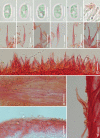Four new species of Mycenasect.Calodontes (Agaricales, Mycenaceae) from northeast China
- PMID: 36761907
- PMCID: PMC9849094
- DOI: 10.3897/mycokeys.93.86580
Four new species of Mycenasect.Calodontes (Agaricales, Mycenaceae) from northeast China
Abstract
Species of Mycenasect.Calodontes are representative of the Mycena genus as a whole and are easily recognised by the pinkish, reddish, purplish to brownish pileus and larger basidiomata. Furthermore, the colour of the pileus in the species of sect. Calodontes often has a transition or changes in different stages and the combination of the colour of the pileus with cystidia and basidiospores can be used to recognise taxa within this section. To date, 19 species of Mycenasect.Calodontes have been reported worldwide. Including our recent description of M.yuezhuoi, five species of sect. Calodontes have been recorded in China. During examination of specimens collected in coniferous forests or mixed broadleaf-conifer forests in temperate regions of China, additional taxa assigned to sect. Calodontes were identified. Four new species are recognised, based mostly on characters of the pileus and cystidia. Phylogenetic analysis of sequence data from multiple DNA regions (ITS + rpb1 + tef1) supported the morphological evidence. Here, we propose M.polycystidiata, M.rufobrunnea, M.shengshanensis and M.subulata as new species in Mycenasect.Calodontes. Morphological descriptions, line drawings, habitat photos and comparisons with closely-related taxa are provided. A key to the 23 known species of sect. Calodontes is presented.
Keywords: coniferous forest; new taxa; phylogeny; saprobic; taxonomy.
Zewei Liu, Yupeng Ge, Hui Zeng, Xianhao Cheng, Qin Na.
Figures















References
-
- Aravindakshan DM, Manimohan P. (2015) Mycenas of Kerala. PhD Thesis, University of Calicut, Kerala, India. 10.13140/RG.2.1.2116.4003 - DOI
-
- Aronsen A, Læssøe T. (2016) The Genus Mycena s.l. Fungi of Northern Europe Vol. 5. Narayana Press, Gylling, Denmark, 373 pp.
-
- Berkeley MJ. (1836) Fungi. In: Smith JE (Eds) The English flora. Longman, Hurst, Rees, Orme, Brown, and Green, London, 5(2): 43. 10.5962/bhl.title.6340 - DOI
-
- Clémençon H, Emmett V, Emmett EE. (2004) Cytology and Plectology of the Hymenomycetes. Bibliotheca Mycologica, Vol. 199. J. Cramer, Berlin, Stuttgart, 488 pp.
LinkOut - more resources
Full Text Sources
